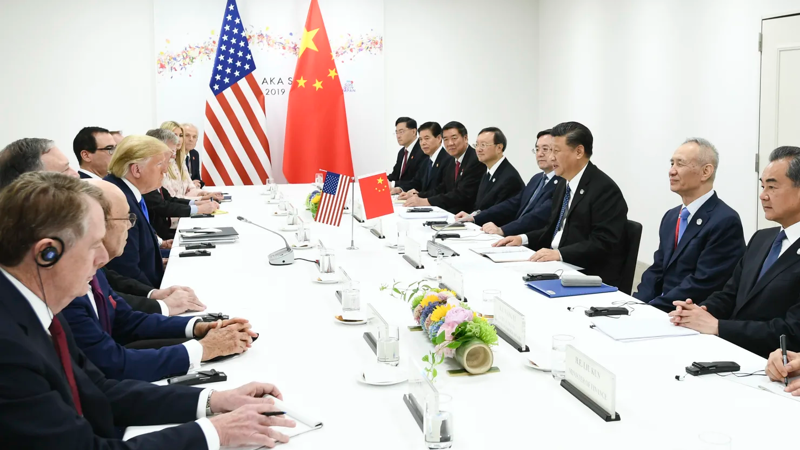According to many leaders of logistics and retail businesses, even if the US and China reach an agreement, the damage to consumers and the economy still exists...

Chinese President Xi Jinping meets with US President Donald Trump in Osaka, Japan, on June 29, 2019 during Trump's first term - Photo: Getty Images
President Donald Trump on June 11 announced that the trade agreement between the United States and China was "complete". According to U.S. Commerce Secretary Howard Lutnick, U.S. tariffs on Chinese imports will not increase further and remain at the current 55 percent.
This 55% figure includes the 20% tariff imposed by the Trump administration due to the fentanyl addiction problem, a 10% reciprocal tax and a 25% tax on certain categories.
However, according to many logistics and retail business leaders, even if the U.S. and China reach an agreement, the damage to consumers and the economy remains.
Currently, import orders from China to the US have decreased after the first months of the year when businesses promoted imports on the eve of reciprocal tariffs. Many U.S. companies are preparing for a slowdown in economic growth.
"I think the real economic data will deteriorate soon," Jamie Dimon, CEO of JPMorgan, said at an event on June 11.
According to Alan Baer, CEO of logistics company OL USA, the current 55% tariff on Chinese goods will put hundreds, if not thousands, of businesses in a difficult situation and lead to thousands of workers who may lose their jobs.
"Very few companies can reprice products to absorb tariffs or raise prices to offset the impact of tariffs," Baer told CNBC. "In the end, consumers have to suffer."
According to many US exporters, the 55% tariff is still too high for them to restore orders as before.
"A 55 percent tariff on goods from China will cause significant instability for consumer goods companies that are importing goods from China," said Bruce Kaminstein, founder and former CEO of sanitary products company Casabella. "President Trump recently said that he doesn't want the U.S. to produce T-shirts. So why did he do it? Does he want to make a spoon of flour? I don't think so."
According to US inflation data released last week, the price increase is lower than expected but price volatility will remain large due to uncertainty about tariff policy.
According to Kaminstei, most U.S. importers are doing business with gross profit margins of about 40%-60%. Therefore, a significant price increase or cutting costs to survive will put additional pressure on cash flow for these companies.
"The 55 percent tariff on the largest U.S. apparel and footwear suppliers, plus the already high MFN and Section 301 tariffs of the U.S. Trade Act, does not benefit the United States," said Steve Lamar, CEO of the American Apparel and Footwear Association (AAFA). observe.
"We're watching the situation closely, but the reality is: Nearly all clothing and footwear sold in the U.S. are now subject to higher tariffs. Rising prices will hit American families hard, especially as they prepare to shop for the new school year and the holiday season. The authorities will not be able to reach new trade agreements to reduce tariffs," Lamar said.
The Chinese government has not confirmed Trump's announcement of "completion" of the trade deal, but has only confirmed that Beijing agrees with the terms of the "truce" agreement reached by the two sides in Geneva, Switzerland early last month. In a post on Truth Social on June 11, Trump said the deal was subject to final approval by him and Chinese President Xi Jinping.
Also on June 11, U.S. Treasury Secretary Scott Bessent said Washington could extend tariff moratoriums for negotiating trading partners "in good faith."
Tariff uncertainty is also affecting the European Union's (EU) exports to the United States. Lutnick also said on June 11 that a U.S.-EU trade deal is likely to be final, in part because of the workload that needs to be dealt with a multi-country bloc rather than a single government.
US-EU carriers are worried about the current context. Andrew Abbott, CEO of Atlantic Container Lines, said that while the pace of imports and exports has been good, he is worried about the upcoming change due to tariff uncertainty and persistent fears of an economic slowdown.
According to Dean Croke, chief analyst at AT Freight & Analytics, trucking companies are worried about the rest of the year.
The U.S. trucking industry is facing many challenges. While imports account for only about 10% of road transport demand, domestic production is the main driver of this industry. However, transport demand is declining due to the dismal agricultural season - another driver of the industry - and weakening consumer demand.
"I think the damage to the transportation industry has existed. They will have to struggle to recover. Supply chains will not be able to recover until trade deals are implemented. Once you've lost trust, how can you make a business decision when everything can fall apart with just one social media post? You have to anticipate the worst."
Since the beginning of the year, the volume of exports from some of the top trading partners to the US has dropped sharply. According to CNBC's aggregate data, the number of 20-foot containers exported from Italy to the US fell by 15% compared to the same period last year, China fell by 11% and South Korea fell by 9%. Particularly, Vietnam and India increased by 21% and 13% respectively because these are two countries in the China +1 strategy of many businesses.











